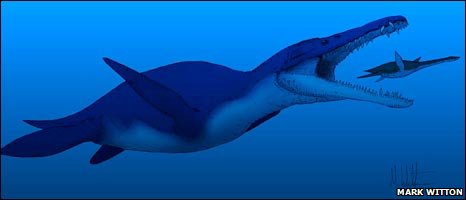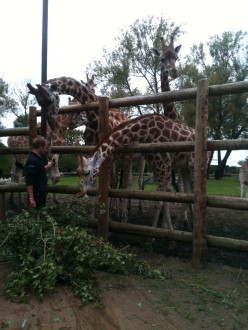A couple of weeks ago I described the report in Nature that suggested it was possible to determine what colour feathered dinosaurs were. Now there’s a report in Science magazine – not yet published – that does the same trick, with a different dino. Jerry Coyne has blogged on this over at Whyevolutionistrue.com. The beast in question is Anchiornis huxleyi, a small (woodpecker-sized) feathered but non-flying dinosaur from about 150 million years ago. It looks cute:

Reconstruction of the plumage color of Anchiornis huxleyi. Color plate by Michael A. Digiorgio, from Science.
The authors say that because it was a non-flying dinosaur, these striking feathers suggest that colouration (and hence signalling or camouflage) may have been as important as aerodynamics in the early evolution of feathers. Jerry points out that you had to have feathers first, so the first appearance of feathers must have had some other advantage.
However, without wishing to be cynical, maybe this is all a big yawn. Certainly, it will be tough to get such papers published it high ranking journals again (I can’t see Nature filling its pages with pretty reconstructions of feathered dinos), so unless they can work out what colour Stegosaurs were (they didn’t have feathers. We think), or make some similar striking novel insight it I reckon that’s it.
Indeed, depending on how complicated it is to carry out these analyses (and only a few fossils apparently retain the necessary melanosomes) there may even be a decline in this kind of work, because it couldn’t be published in the likes of Nature or Science, in that it would just be one more coloured dinosaur.
However, there is another point, raised by two posters, Bex and Finch, on my previous article. Both of them yawned, for different reasons. Are they right?
Bex: Are you sure this is a very relevant issue? I mean, yes, it may be interesting … the possibility to provide some (feeble) inferences on behaviour, maybe even metabolism. But maybe this is not so amazing. Maybe it is just … cool: arresting images, nice colours, and the old stuff about charming dinosaurs. “Nature” seems to love appealing news, they are more attractive that … “tedious science”! Maybe dinosaurs had blue tails, maybe Neanderthals had red hair. Science or gossip? Once more, this is interesting, but … so much interesting?
Finch: Although interesting, I see nothing surprising in this article. It is just one of a number of “cosmetic” articles that journals like Nature love to publish. I mean there is not much science in this article, but many funny and cool things for newspapers and media, in general. Moreover, the title of this article, as well as many statements done throughout the text, are very misleading. In fact, the results of this study just show that some coelurosaurs had pigments in their (proto)feathers, while the authors use the term “dinosaurs”, which includes many many more species than coelurosaurs does. Of course, it is more cool to say that dinosaurs had colors, but this statement is not scientific and conveys the false message that dinosaurs like T. rex or Triceratops had colored feathers. Just imagine if Spielberg just read the title and decides to make a Jurassic Park 4 with a T. rex in red and blue feathers! Yes, very cool, but not real!




